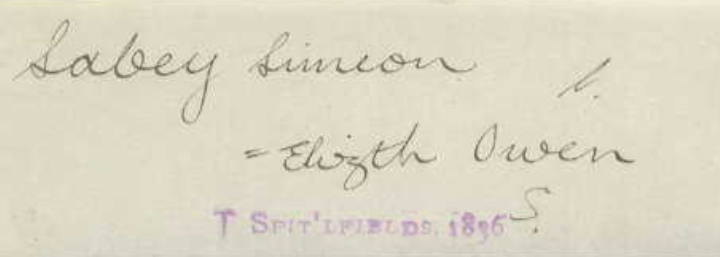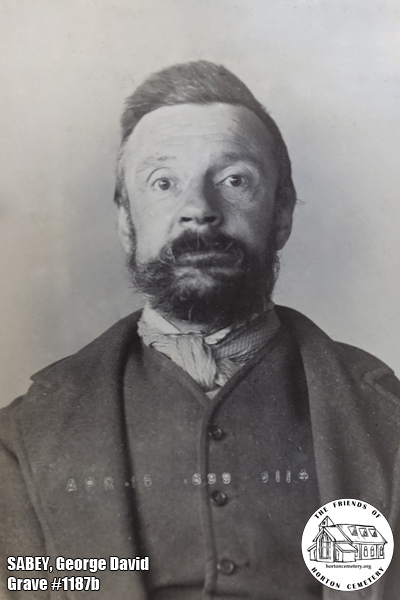b.1843 – d.1911

George was born on the 1st May 1843 in Shoreditch, and was baptised at St Leonard’s Church on 14th May 1843. His parents were Simeon and Elizabeth Sabey and they were living in North Street, Cripplegate, Shoreditch, Simeon was a carpenter.
“Joshua Solomon (b1832) occupation ale house keeper of Metropolitan House, 1 North Street, St Giles without Cripplegate.” This is the only reference I can find online to say that North Street existed, I believe it lay between Redcross Street and Whitecross Street.
George David Sabey was the third of four sons born to Simeon Sabey (1801-1855) and Eliza Owen (1813-1867) the eldest, Walter Owen (1839-1862), the short-lived Albert Edward (1841-1842), the youngest Albert Edward Charles (1846-1917).
Simeon and Elizabeth married at Christchurch, Spitalfields, Stepney, Middlesex on 30th March 1836.

Simeon originally came from Steeple Morden, Cambridgeshire and was one of eight children born to William Sabey and and Susanna (Susan) Newman/Numan.
Simeon’s siblings were…
Rebeckha bn 1804, Samuel bn 1808, Fanny bn 1810, Susannah bn 1812, Allen bn 1815, Charles bn 1819 and David bn 1823. All were born in Steeple Morden, Cambridgeshire.
1840s

The 1841c states that Samuel was a carpenter and most of his son’s appear to have followed their father and become carpenters or builders. Simeon received the freedom of the city of London on 23rd Nov 1843 having served his apprenticeship.
Several of Samuel’s sons, possibly including Simeon, travelled to USA in around 1837, some remained and built new lives there whilst others, including Simeon, returned.

Elizabeth Sabey nee Owen came from Bromsgrove, Worcestershire although it is recorded on various censuses as Middlesex/Shropshire.

In the 1841 Census the family were living in Bell Yard in the Parish of St Gregory by St Paul’s, with their first born son Walter Owen 2yrs and Albert Edward 6months. Sadly Albert died in 1842 aged just 2yrs and is buried in St Giles, Cripplegate, now part of the Barbican complex.
By 1843 they had moved to North Street, Cripplegate (next to the charity school) where they lived for some years, but by the time of the 1851 Census they had moved again, to Banner Street, Finsbury, in the Parish of St Luke.
At this time Walter was 12yrs, George David was 8yrs old and their youngest; Albert Edward Charles was 3yrs. According to later hospital records George was born with a “mild congenital defect” he was very late to walk and “did not speak until about 6 or 7 years old”. However he later learned to read and write and went on to earn his own living from his home as a bootmaker. Before his troubles began he had £40 in the Building Society.
Sadly in 1855 Simeon died of cancer and was buried on 8th June in Victoria Park Cemetery, Hackney. His address was given as Brick Lane, St Luke’s.
Brick Lane later became Central Street, and run’s across the eastern end of Banner Street. Simeon, Elizabeth and their family remained in this relatively small area of east London throughout their lives, only George was forced away by his health problems.
Elizabeth dies
All three boys continued to live at home with their widowed mother, and in the 1861 Census they are living at 5 St John’s Row, Finsbury (Parish of St Barnabus). Elizabeth was making a living as a dressmaker. Walter now 21yrs was a carpenter and George David, 17yrs, is shown as a bootmaker. Young Albert aged 15yrs is a walking stick maker. This is the last census that shows the family together.
In 1867 Elizabeth died and was buried on 16th Aug 1867 in the Victoria Park Cemetery, Hackney. Her address was given as Lever Street, St Luke’s.
No census for 1971 has been found to locate the family. By 1881, we find George David age 37yrs. We know that prior to this time George was running a good business as a bootmaker from his own home, but at some point he was asked to quit the premises.
He moved to Hoxton but lost his customers and finance became a worry, at which time he moved in with his younger brother Albert and his family in Lever Street, St Luke. The 1881 Census shows that he is still working as a boot maker.
It seems that shortly after this time George’s problems became too much for him and his records say that “he took to sitting and worrying and began to neglect himself”. Eventually in 1883 he was admitted to the Greys Inn Road Work House. From there he is sent to the City Road Work House, St Luke’s (16.8.83) who quickly passed him on to Colney Hatch Lunatic Asylum where he is admitted on 28th August 1883. This is where he spent the next 20 years.

In 1868 the recently formed Metropolitan Asylums Board set up six new Sick Asylum Districts for the purpose of providing hospital care for the poor on separate sites from workhouses. The new Finsbury district needed larger premises which were felt to be too expensive and so the Finsbury Sick Asylum District was reconstituted as an enlarged Holborn Union.
They redeployed existing sites to provide separate workhouse and hospital accommodation. Holborn’s Greys Inn WH was designated for able-bodied inmates and the former St Luke’s WH on City Rd was adapted for use as a union hospital.
1900s and a fire
The 1901c shows George still in Colney Hatch and working as a shoemaker.
Colney Hatch was opened in 1851 the largest and most modern asylum in Europe and also the most expensive ever built. Numbers grew and by 1857 it housed 2,000 inmates, but by 1858 serious defects in construction had began to appear.

In 1903, the year that George was transferred to the Ewell Epileptic Colony, a fire occurred in a temporary building killing fifty one people, the worst disaster in English asylum history.
On the 29th October 1903 George was transferred again, this time to the new Epileptic Colony in Epsom, Surrey where he lived until his death in 1911.
The Epsom Cluster comprised five asylums built between 1899 and 1924. The Colony opened in 1903 to cater for the “Epileptic insane of the Metropolis” and offered some new treatments recently available. Patients, or Colonists as they were known, lived in groups in small bungalows taking away the stigma of the “Asylum”. They contributed to the whole of the cluster by working in some capacity in the laundry or the bakery, the kitchen or the shoe shop or outside, in the garden or on the farm.
What the records tell us
His records show that he was admitted in good health, physically well developed with dark brown hair and hazel eyes. At one point it says that his Epileptic fits began in childhood but in another that his first fit occurred aged 40yrs.
Asked about his surroundings past and present he said he “does not know” and throughout his case notes he says, “I am a dead man”. He also has delusions in which he believes he is a judge and “will judge everybody”. However he is noted as a quiet, intelligible and compliant.
As the years pass George seems to remain in relatively good physical health and is said to be a good worker in the shoe shop but slowly his mental health deteriorates and he is diagnosed with Epileptic Dementia. He becomes confused, excitable, irritable and sometimes angry with other colonists. His conversation also becomes irrational and sometimes incoherent and he is less able to work.
In February 1911 we suddenly find a “Notice of Escape” sent to “C in L”. George wandered to the roads of the Horton Estate, without any intention of escaping and was recaptured.

In 1911, there is an entry for George, who is shown as 68 years old and a bootmaker. That census was taken on April 2nd.

George died on the last day of 1911 of “General arterial sclerosis and heart failure”. He was buried in Horton Cemetery on 4th Jan 1912 in grave 1187b.
George’s siblings
George’s older brother Walter Owen died unmarried aged just 22yrs on 4th Jan 1862 in St Georges or Kings College Hospital (probate and burial records differ)
and left money to his mother Elizabeth of 184, Lever Street. Which was unusual for such a young man.

The Victoria Park Cemetery Company was a private enterprise which opened the new cemetery in 1845 to meet the growing need of the East End. From the beginning it was badly run and soon ran into financial difficulties eventually going bankrupt in 1845. Some very interesting and rather upsetting information is available at http://thelondondead.blogspot.com/2021/02/the-resort-of-thieves-and-harlots.html
Albert Edward Charles was living in Islington in the 1911c with is wife Eliza nee Varney. They had married in 1872 by which time they already had son James born 1870. He was joined in 1873 by a brother Walter Owen and then in 1875 by daughter Elizabeth Owen.
On 30th June 1914 Albert was admitted to the St John’s Rd, Workhouse/Infirmary and is listed as “not able bodied”. He died in March 1917 and was buried on 17th March in Islington. His wife Eliza appears to have live on until 1932 when she died ages 86 years
Authors note
This sad case has so many parallels with those we see around us today whose lives are upended by sudden changes in their circumstances, loss of work, home, self worth, tipping their already fragile mental health over the edge. Today, of course, George would have received medical care for his Epilepsy and support for his mental health and his life might have been totally different.




